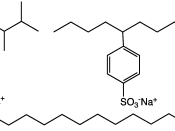Phosphates may be created by substituting some or all of the hydrogen of a phosphoric acid by metals. Depending on the number of hydrogen atoms that are replaced, the resulting compound is described as a primary, secondary or tertiary phosphate. Primary and secondary phosphates contain hydrogen and are acid salts. Secondary and tertiary phosphates, with the exception of those of sodium, potassium and
ammonium are insoluble in water. Tertiary sodium phosphate is valuable as a detergent and water softener. The primary phosphates tend to be more soluble.
Phosphates, which are an important component to metabolism in both plants and animals, help in the first step in oxidation of glucose in the body. Primary calcium phosphate is an ingredient of plant fertilizer.
Phosphates have caused increasing attention recently. The focus is on the environmentally harmful effects in household detergents. Wastewater, from laundering agents, contains phosphates, which are said to be a water pollutant.
Most laundry detergents contain approximately 35% to 75% sodium
triphosphate (Na5P3O10), which serves two purposes. Providing an alkaline solution (pH 9.0 to 10.5) is necessary for effective cleansing and also to tie up calcium and magnesium ions found in natural waters and prevent them from interfering with the cleansing role of the detergent.
Eutrophication is the progressive over-fertilization of water, in which festering masses of algae's blooms, choking rivers and lakes. Phosphorus compounds act as a fertilizer for all plant life, whether free-floating algae or more substantial rooted weeds, and are implicated in eutrophication. Many countries control phosphate levels, whereas
Switzerland has banned the use of phosphates.
The marine environment is both fragile and more resistant than the terrestrial ecosystem. It is fragile for the reasons that nutrients are generally present in very low concentrations, permanently consumed by living organisms and pollutants diffuse rapidly.
Lakes and rivers...


![[Electric phosphate smelting furnace used in the making of elemental phosphorus in a TVA chemical plant in the Muscle Shoals area, Alabama] (LOC)](https://s.writework.com/uploads/5/59734/electric-phosphate-smelting-furnace-used-making-elemental-p-thumb.jpg)